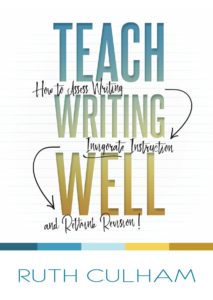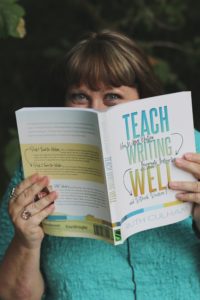Still Learning From Mr. Rogers
By: Lester Laminack
Mr. Rogers understood and demonstrated the elegance and power in simple and consistent structures and routines. His framework was predictable and visible, even to his young viewers. Think about the opening scene for any episode. He enters and speaks to you, directly to you, in the singular. He sings and moves toward the closet where he unbuttons his jacket, removes it, and hangs it in the closet. He takes his sweater from a hanger, puts it on and buttons or zips. Then he steps down to a bench where he removes his loafers, neatly tucks them away before slipping his foot into one sneaker and tying it, and then the other. In that simple routine, he greets you, speaks directly to you and engages you in the familiar song that is your welcome each time you visit. During the time it takes to sing that simple song he demonstrates buttoning/unbuttoning, zipping/unzipping, tying/untying, and putting things where they belong so you can locate them the next time. And, then, at the end of each episode, he does it all again as he makes his way to the door signaling the closure of our time together.
Each of the daily routines is paired with a song or his gentle, focused voice giving you an overview of what he has planned. He tells you what to expect as he begins to unfold the episode and you move forward with a story, a visit to picture-picture for a virtual field trip or a deeper look into a topic, or he phones a neighbor to request permission to bring you along for visit, or on occasion someone drops in to visit with you. In all this, he models civility and the importance of planning and preparation, the efficiency of reflection and thought before action.
These simple routines remind us of the impact a consistent practice can have. They provide a structure that enables our students to anticipate what is coming next. It sets them up to prepare their materials and their mindset.
What You Can Learn From Mr. Rogers
Each episode includes time for nurturing the imagination. You know Mr. Rogers will lead you there when he takes a seat on the bench next to Trolley. Almost always the plan for “make-believe” will extend the theme of the day (e.g. worry, feelings, competition, mistakes). As you move through the tunnel and come out on the other side in “The Land of Make Believe” you have trusted friends there as well, ( e.g. X the Owl, Henrietta Pussycat, Lady Aberlin, Mr. McFeely, Daniel Striped Tiger, and others). You know that in each visit several of these trusted friends will be involved in some drama of their own. The storyline is typically simple and relatable, the variety of characters lets you see that it is possible for the same events to be perceived differently by a group of individuals. Feelings get hurt, friends realize their comments and or actions can inadvertently cause another to feel bad. You see the powerful positive impact of heartfelt apologies and the opportunity to change thinking and behavior. Perhaps the beauty of those simple puppets is that they can say things you feel; things you may not have the words to say or that you may not be sure it is ok to say. Mr. Rogers and your friends in “The Land of Make Believe” allow you to acknowledge feelings even before you can name them, to see the impact of words and actions and to understand that you have control of your own.
The entire episode moves through a series of events or scenes hinged one to another with a simple routine (e.g. an action, a movement, a song). The predictability of his routine does not result in boredom; rather it brings a sense of stability in a world of the fast-paced, ever-changing schedules and routines in the lives of children. There is never a wasted moment, yet there is never a moment when you feel rushed. There is no pressure to do it right or do it better. There is no suggestion that your value as a person hinges on your success with any activity. Instead, Mr. Rogers assures you over and over again that you are enough just the way you are. He assures you that he is proud to be your neighbor and that you are the only you in this great wide world.
Important lessons for Teachers
Mr. Rogers is still teaching us. His show spanned over 30 years and in that time his structures and routines remained consistent. Let’s pause here to consider what this can mean for us today.
- Each of us desires to be acknowledged, to have our humanity recognized and confirmed. Mr. Rogers greets you and makes you feel welcome. We owe that to our students, each of them deserves to be acknowledged and welcomed each day.
- Simple structures, rituals, and routines help us focus and move into the frame of mind needed to engage. Mr. Rogers had songs that marked various transitions in the visit. We can easily adapt that to sharing a poem, a song, or a rhyme that is age appropriate to mark the opening and closing of a class meeting.
- Unspoken visible rituals can be effective as transition markers. Mr. Rogers had several of these including his jacket, sweater, loafers, sneakers, feeding the fish, and more. We can adapt these easily. Designate a stool for read-aloud and sit on it only when sharing a text. Or set aside a cap or hat that you wear only when reading aloud. You may keep a pair of reading glasses on a shelf next to the basket of read-aloud texts for the week. Wear those particular glasses only when you share a text. Simple routines send clear messages that soon become a part of the classroom culture.
- Civility is learned. Mr. Rogers was a living model of civility. He was always kind. He never had an unkind word for or about anyone. He greeted visitors warmly and genuinely. He always phoned ahead to request permission to visit and to bring you along with him. He was conscious of the feelings of others. Today we often hear adults lament the loss of civility. Well, my friends, it is we adults who must be the models of what it looks like and why it is needed. This one is easy, but essential.
- Planning and advanced preparation reduces anxiety and increases efficiency. In each episode, Mr. Rogers talks through his plans for our visit. He poses questions, offers ideas, reflects, and then takes action. He invites us to think. Consider the importance of sharing aloud your plan for the day. When students know how the class will unfold and how each piece fits into the whole we reduce the potential for misunderstanding, misconnections, and misbehavior.
- Imagination is a powerful tool. Mr. Rogers folded imagination/pretend into each episode. It was in our visits to “The Land of Make Believe” that we had an opportunity to see the “theme” of the episode play out inside the stories of a familiar cast of characters. As teachers, we recognize the importance of giving our students multiple access points to the lesson. Follow Mr. Rogers’ lead and offer students the opportunity to imagine and to consider the lesson through a different lens.
Keep in mind that children thrive on routines, kindness, and recognition of what they do well. Reach and develop the imagination of every child you teach, for heightened imagination is a path to creative thinking.
Lester’s books are on Amazon!
Learn more about Lester Laminack, check out his website!
Follow Lester on Twitter @lester_laminack
![]()










